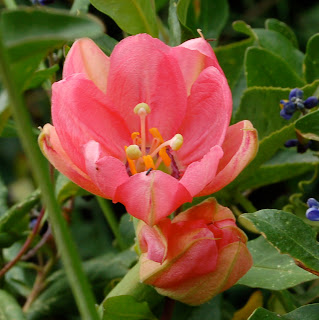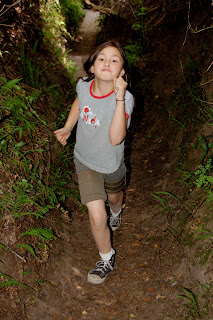Rumi means stone and pamba means pampa or plains. There are remains of huge stones from the last eruption of Guagua Pichincha volcano, which occurred in 1660. Scattered throughout the grounds are excavations of walls and houses and tombs and roads dating from 500 to 1500 AD, with Quitu ceramics shown in the hacienda. The grounds are extensive, so I imagine there are many more structures to be excavated under our feet. The Banco Central is planning to open another complex with a museum nearby and there was evidence of further work to uncover more remains.

A 'culunco' is an antique path constructed by the Yumbo people, who also originally settled the cloud forest north or Quito. The Yumbo were traders, and used these culuncos to transport goods between the Andes and the coast and the Amazon. When we rode horses at Pululahua, we rode through a culunco, which are carved into the earth by years of use and erosion and are covered by branches and almost impossible to detect from a distance. Maya and I ran the length of one of these culuncos at Rumipamba, which was narrow and deep and a little creepy. They are invisible from the surface, and covered with moss and overhanging branches.
Rumipamba was an oasis of peace and tranquility in the midst of the noisy, busy city, and one can almost forget that Quito is all around us. It is a sanctuary for insects and birds and small animals. We learned that when the Spaniards conquered the city there was a massive lake in the middle of the city, between what is now the airport and Guapulo. I am not sure what happened to the lake or why it disappeared.
Maya and Eric were not too impressed with the ruins and it took lots of convincing to get them out of the house in the first place, but they became more interested and enthusiastic once we started walking through the ruins. The guard later told us that on most days there are guides who provide extensive explanations about the remains and the culture of the Quitu. Unfortunately today there was a meeting of the president of city parks and his colleagues, so no tours were provided.
We will return to Pululahua tomorrow to ride horses and explore more caluncos, and perhaps see some more archeological remains.
View of Quito From Rumipamba




 Quitu Mortar and Pestle
Quitu Mortar and Pestle Maya Running Through Yumbo Trail
Maya Running Through Yumbo Trail


No comments:
Post a Comment